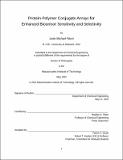Protein-polymer conjugate arrays for enhanced biosensor sensitivity and selectivity
Author(s)
Paloni, Justin Michael.
Download1193321545-MIT.pdf (25.20Mb)
Other Contributors
Massachusetts Institute of Technology. Department of Chemical Engineering.
Advisor
Bradley D. Olsen.
Terms of use
Metadata
Show full item recordAbstract
The capability of biosensors to provide highly sensitive and selective molecular detection has enabled development of rapid, inexpensive medical diagnostics. Despite significant advancements in sensor design over the past several decades, most biosensors experience significantly reduced sensitivity in common sensing fluids such as blood and urine. In these mixtures, off-target molecules nonspecifically bind to the sensor surfaces, blocking analyte binding sites and increasing background signal. The self-assembled structure of protein-polymer conjugates presents a potential solution to this issue, offering both biological functionality and a mechanism for excluding many non-analyte molecules in biosensing fluids. Therefore, this thesis explores the use of protein-polymer conjugate thin films as biosensors to minimize nonspecific binding effects during detection in complex mixtures. The first part of this thesis focuses on protein engineering methods to improve the self-assembly of protein-polymer conjugates. It is first demonstrated that oligomerization of low-molecular weight protein blocks significantly enhances ordering quality of the corresponding conjugates. As the degree of oligomerization of the protein block increases, conjugates form ordered phases that display longer-range assembly. Another technique shown to improve protein-polymer conjugate self-assembly is fusion of complementary coiled-coil sequences to the protein block. When proteins bearing these sequences are mixed together in solution, a strongly associative coiled-coil forms, promoting a substantial ordering improvement. Both protein oligomerization and fusion to coiled-coil sequences retain the biological functionality of the protein block, and it is found that protein activity generally scales with conjugate ordering quality. The second part of this thesis explores the capabilities of the polymer block in protein-polymer conjugate thin films to control diffusion into these films. By increasing the molecular weight of this polymer block, larger analyte molecules experience less restricted diffusion into the thin films. Transport studies performed in solutions of the polymer block indicate that most proteins display size-based diffusion following the Stokes-Einstein equation, but some proteins deviate significantly from this behavior due to a combination of protein-protein and protein-polymer interactions. When an analyte molecule is mixed with a protein that diffuses faster than the analyte in these polymer solutions, the sensitivity of the thin film conjugate biosensors towards the analyte is often significantly enhanced. This sensitivity improvement is also observed during detection in mixtures containing the analyte and several proteins, only some of which diffuse faster than the analyte. Accordingly, biosensing measurements using protein-polymer conjugate thin films performed in blood serum and urine solutions, which should contain a variety of proteins that diffuse faster than a given analyte, display a two order of magnitude improvement in sensitivity over traditional surface-based biosensor technologies. Thus, protein-polymer conjugate thin film biosensors can overcome nonspecific binding effects and demonstrate greater sensitivity during measurements performed in complex protein mixtures.
Description
Thesis: Ph. D., Massachusetts Institute of Technology, Department of Chemical Engineering, May, 2019 Cataloged from the official PDF of thesis. Includes bibliographical references.
Date issued
2019Department
Massachusetts Institute of Technology. Department of Chemical EngineeringPublisher
Massachusetts Institute of Technology
Keywords
Chemical Engineering.